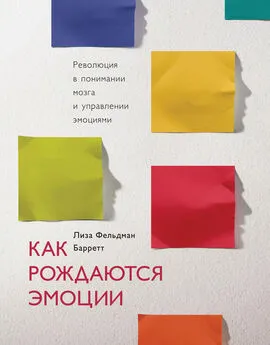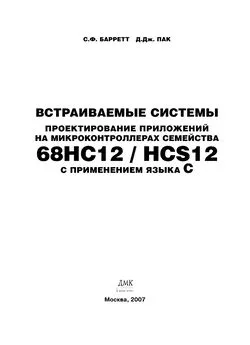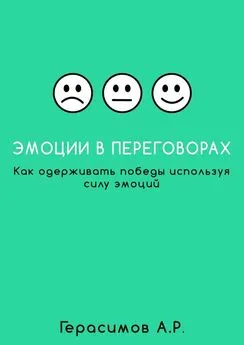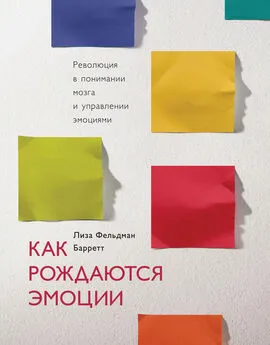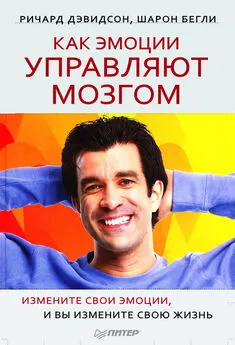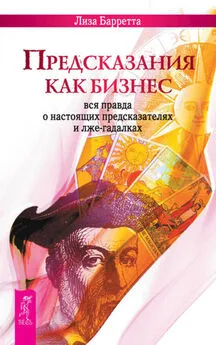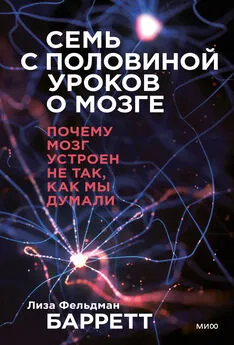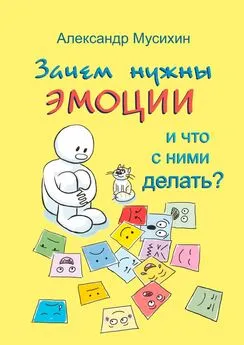Лиза Барретт - Как рождаются эмоции
- Название:Как рождаются эмоции
- Автор:
- Жанр:
- Издательство:Манн, Иванов и Фербер
- Год:2018
- Город:Москва
- ISBN:нет данных
- Рейтинг:
- Избранное:Добавить в избранное
-
Отзывы:
-
Ваша оценка:
Лиза Барретт - Как рождаются эмоции краткое содержание
Эта книга совершает революцию в понимании эмоций, разума и мозга. Вас ждет захватывающее путешествие по удивительным маршрутам, с помощью которых мозг создает вашу эмоциональную жизнь. Вы научитесь по-новому смотреть на эмоции, свои взаимоотношения с людьми и в конечном счете на самих себя. На русском языке публикуется впервые.
Как рождаются эмоции - читать онлайн бесплатно ознакомительный отрывок
Интервал:
Закладка:
Verosupertramp85. 2012. “Lost in Translation.” January 13. http://verosupertram.wordpress.com/2012/01/13/lost-in-translation.
Voorspoels, Wouter, Wolf Vanpaemel, and Gert Storms. 2011. “A Formal Ideal-Based Account of Typicality.” Psychonomic Bulletin and Review 18 (5): 1006–1014.
Vouloumanos, Athena, Kristine H. Onishi, and Amanda Pogue. 2012. “Twelve-Month-Old Infants Recognize That Speech Can Communicate Unobservable Intentions.” Proceedings of the National Academy of Sciences 109 (32): 12933–12937.
Vouloumanos, Athena, and Sandra R. Waxman. 2014. “Listen Up! Speech Is for Thinking During Infancy.” Trends in Cognitive Sciences 18 (12): 642–646.
Wager, T. D., J. Kang, T. D. Johnson, T. E. Nichols, A. B. Satpute, and L. F. Barrett. 2015. “A Bayesian Model of Category-Specific Emotional Brain Responses.” PLOS Computational Biology 11 (4): e1004066.
Wager, Tor D., and Lauren Y. Atlas. 2015. “The Neuroscience of Placebo Effects: Connecting Context, Learning and Health.” Nature Reviews Neuroscience 16 (7): 403–418.
Wager, Tor D., Lauren Y. Atlas, Martin A. Lindquist, Mathieu Roy, Choong-Wan Woo, and Ethan Kross. 2013. “An fMRI-Based Neurologic Signature of Physical Pain.” New England Journal of Medicine 368 (15): 1388–1397.
Walker, A. K., A. Kavelaars, C. J. Heijnen, and R. Dantzer. 2014. “Neuroinflammation and Comorbidity of Pain and Depression.” Pharmacological Reviews 66 (1): 80–101.
Walker, Suellen M., Linda S. Franck, Maria Fitzgerald, Jonathan Myles, Janet Stocks, and Neil Marlow. 2009. “Long-Term Impact of Neonatal Intensive Care and Surgery on Somatosensory Perception in Children Born Extremely Preterm.” Pain 141 (1): 79–87.
Walløe, Solveig, Bente Pakkenberg, and Katrine Fabricius. 2014. “Stereological Estimation of Total Cell Numbers in the Human Cerebral and Cerebellar Cortex.” Frontiers in Human Neuroscience 8: 508.
Wang, Jing, Ronald J. Iannotti, and Tonja R. Nansel. 2009. “School Bullying Among Adolescents in the United States: Physical, Verbal, Relational, and Cyber.” Journal of Adolescent Health 45 (4): 368–375.
Waters, Sara F., Tessa V. West, and Wendy Berry Mendes. 2014. “Stress Contagion Physiological Covariation Between Mothers and Infants.” Psychological Science 25 (4): 934–942.
Waxman, Sandra R., and Susan A. Gelman. 2010. “Different Kinds of Concepts and Different Kinds of Words: What Words Do for Human Cognition.” In The Making of Human Concepts , edited by Denis Mareschal, Paul C. Quinn, and Stephen E. G. Lea, 101–130. New York: Oxford University Press.
Waxman, Sandra R., and Dana B. Markow. 1995. “Words as Invitations to Form Categories: Evidence from 12- to 13-Month-Old Infants.” Cognitive Psychology 29 (3): 257–302.
Wegner, Daniel M., and Kurt Gray. 2016. The Mind Club: Who Thinks, What Feels, and Why It Matters . New York: Viking.
Wei, Qiang, Hugh M. Fentress, Mary T. Hoversten, Limei Zhang, Elaine K. Hebda-Bauer, Stanley J. Watson, Audrey F. Seasholtz, and Huda Akil. 2012. “Early-Life Forebrain Glucocorticoid Receptor Overexpression Increases Anxiety Behavior and Cocaine Sensitization.” Biological Psychiatry 71 (3): 224–231.
Weierich, M. R., C. I. Wright, A. Negreira, B. C. Dickerson, and L. F. Barrett. 2010. “Novelty as a Dimension in the Affective Brain.” Neuroimage 49 (3): 2871–2878.
Weisleder, Adriana, and Anne Fernald. 2013. “Talking to Children Matters: Early Language Experience Strengthens Processing and Builds Vocabulary.” Psychological Science 24 (11): 2143–2152.
Westermann, Gert, Denis Mareschal, Mark H. Johnson, Sylvain Sirois, Michael W. Spratling, and Michael S. C. Thomas. 2007. “Neuroconstructivism.” Developmental Science 10 (1): 75–83.
Whitacre, James, and Axel Bender. 2010. “Degeneracy: A Design Principle for Achieving Robustness and Evolvability.” Journal of Theoretical Biology 263 (1): 143–153.
Whitacre, James M., Philipp Rohlfshagen, Axel Bender, and Xin Yao. 2012. “Evolutionary Mechanics: New Engineering Principles for the Emergence of Flexibility in a Dynamic and Uncertain World.” Natural Computing 11 (3): 431–448.
Widen, Sherri C. In press. “The Development of Children’s Concepts of Emotion.” In Handbook of Emotions , 4th edition, edited by Lisa Feldman Barrett, Michael Lewis, and Jeannette M. Haviland-Jones, 307–318. New York: Guilford Press.
Widen, Sherri C., Anita M. Christy, Kristen Hewett, and James A. Russell. 2011. “Do Proposed Facial Expressions of Contempt, Shame, Embarrassment, and Compassion Communicate the Predicted Emotion?” Cognition and Emotion 25 (5): 898–906.
Widen, Sherri C., and James A. Russell. 2013. “Children’s Recognition of Disgust in Others.” Psychological Bulletin 139 (2): 271–299.
Wiech, Katja, Chia-shu Lin, Kay H. Brodersen, Ulrike Bingel, Markus Ploner, and Irene Tracey. 2010. “Anterior Insula Integrates Information About Salience into Perceptual Decisions About Pain.” Journal of Neuroscience 30 (48): 16324–16331.
Wiech, Katja, and Irene Tracey. 2009. “The Influence of Negative Emotions on Pain: Behavioral Effects and Neural Mechanisms.” Neuroimage 47 (3): 987–994.
Wierzbicka, Anna. 1986. “Human Emotions: Universal or Culture-Specific?” American Anthropologist 88 (3): 584–594.
——— . 1999. Emotions Across Languages and Cultures: Diversity and Universals . Cambridge: Cambridge University Press.
Wikan, Unni. 1990. Managing Turbulent Hearts: A Balinese Formula for Living. Chicago: University of Chicago Press.
Williams, David M., Shira Dunsiger, Ernestine G. Jennings, and Bess H. Marcus. 2012. “Does Affective Valence During and Immediately Following a 10-Min Walk Predict Concurrent and Future Physical Activity?” Annals of Behavioral Medicine 44 (1): 43–51.
Williams, J. Bradley, Diana Pang, Bertha Delgado, Masha Kocherginsky, Maria Tretiakova, Thomas Krausz, Deng Pan, Jane He, Martha K. McClintock, and Suzanne D. Conzen. 2009. “A Model of Gene-Environment Interaction Reveals Altered Mammary Gland Gene Expression and Increased Tumor Growth Following Social Isolation.” Cancer Prevention Research 2 (10): 850–861.
Wilson, Craig J., Caleb E. Finch, and Harvey J. Cohen. 2002. “Cytokines and Cognition—The Case for a Head-to-Toe Inflammatory Paradigm.” Journal of the American Geriatrics Society 50 (12): 2041–2056.
Wilson, Timothy D., Dieynaba G. Ndiaye, Cheryl Hahn, and Daniel T. Gilbert. 2013. “Still a Thrill: Meaning Making and the Pleasures of Uncertainty.” In The Psychology of Meaning , edited by Keith D. Markman and Travis Proulx, 421–443. Washington, DC: American Psychological Association.
Wilson-Mendenhall, Christine D., Lisa Feldman Barrett, and Lawrence W. Barsalou. 2013. “Situating Emotional Experience.” Frontiers in Human Neuroscience 7: 1–16.
——— . 2015. “Variety in Emotional Life: Within-Category Typicality of Emotional Experiences Is Associated with Neural Activity in Large-Scale Brain Networks.” Social Cognitive and Affective Neuroscience 10 (1): 62–71.
Wilson-Mendenhall, Christine D., Lisa Feldman Barrett, W. Kyle Simmons, and Lawrence W. Barsalou. 2011. “Grounding Emotion in Situated Conceptualization.” Neuropsychologia 49: 1105–1127.
Winkielman, P., K. C. Berridge, and J. L. Wilbarger. 2005. “Unconscious Affective Reactions to Masked Happy Versus Angry Faces Influence Consumption Behavior and Judgments of Value.” Personality and Social Psychology Bulletin 31 (1): 121–135.
Wistrich, Andrew J., Jeffrey J. Rachlinski, and Chris Guthrie. 2015. “Heart versus Head: Do Judges Follow the Law or Follow Their Feelings.” Texas Law Review 93: 855–923.
Wittgenstein, Ludwig. 1953. Philosophical Investigations . London: Blackwell.
Wolpe, Noham, and James B. Rowe. 2015. “Beyond the ‘Urge to Move’: Objective Measures for the Study of Agency in the Post-Libet Era.” In Sense of Agency: Examining Awareness of the Acting Self , edited by Nicole David, James W. Moore, and Sukhvinder Obhi, 213–235. Lausanne, Switzerland: Frontiers Media.
Woo, Choong-Wan, Mathieu Roy, Jason T. Buhle, and Tor D. Wager. 2015. “Distinct Brain Systems Mediate the Effects of Nociceptive Input and Self-Regulation on Pain.” PLOS Biology 13 (1): e1002036. doi:10.1371/journal.pbio.1002036.
Wood, Wendy, and Dennis Rünger. 2016. “Psychology of Habit.” Annual Review of Psychology 67: 289–314.
Wu, L. L., and L. W. Barsalou. 2009. “Perceptual Simulation in Conceptual Combination: Evidence from Property Generation.” Acta psychologica (amst) 132 (2): 173–189.
Xu, Fei. 2002. “The Role of Language in Acquiring Object Kind Concepts in Infancy.” Cognition 85 (3): 223–250.
Xu, Fei, Melissa Cote, and Allison Baker. 2005. “Labeling Guides Object Individuation in 12-Month-Old Infants.” Psychological Science 16 (5): 372–377.
Xu, Fei, and Tamar Kushnir. 2013. “Infants Are Rational Constructivist Learners.” Current Directions in Psychological Science 22 (1): 28–32.
Yang, Yang Claire, Courtney Boen, Karen Gerken, Ting Li, Kristen Schorpp, and Kathleen Mullan Harris. 2016. “Social Relationships and Physiological Determinants of Longevity Across the Human Life Span.” Proceedings of the National Academy of Sciences 113 (3): 578–583.
Yeager, Mark P., Patricia A. Pioli, and Paul M. Guyre. 2011. “Cortisol Exerts Bi-Phasic Regulation of Inflammation in Humans.” Dose Response 9 (3): 332–347.
Yeo, B. T. Thomas, et al. 2011. “The Organization of the Human Cerebral Cortex Estimated by Intrinsic Functional Connectivity.” Journal of Neurophysiology 106 (3): 1125–1165.
Yeo, B. T. Thomas, Fenna M. Krienen, Simon B. Eickhoff, Siti N. Yaakub, Peter T. Fox, Randy L. Buckner, Christopher L. Asplund, and Michael W. L. Chee. 2014. “Functional Specialization and Flexibility in Human Association Cortex.” Cerebral Cortex 25 (10): 3654–3672.
Yeomans, Martin R., Lucy Chambers, Heston Blumenthal, and Anthony Blake. 2008. “The Role of Expectancy in Sensory and Hedonic Evaluation: The Case of Smoked Salmon Ice-Cream.” Food Quality and Preference 19 (6): 565–573.
Yik, Michelle S. M., Zhaolan Meng, and James A. Russell. 1998. “Brief Report: Adults’ Freely Produced Emotion Labels for Babies’ Spontaneous Facial Expressions.” Cognition and Emotion 12 (5): 723–730.
Yin, Jun, and Gergely Csibra. 2015. “Concept-Based Word Learning in Human Infants.” Psychological Science 26 (8): 1316–1324.
Yoshikubo, Shin’ichi. 1985. “Species Discrimination and Concept Formation by Rhesus Monkeys (Macaca Mulatta).” Primates 26 (3): 285–299.
Younger, Jarred, Arthur Aron, Sara Parke, Neil Chatterjee, and Sean Mackey. 2010. “Viewing Pictures of a Romantic Partner Reduces Experimental Pain: Involvement of Neural Reward Systems.” PLOS One 5 (10): e13309. doi:10.1093/cercor/bhv001.
Zachar, Peter. 2014. A Metaphysics of Psychopathology . Cambridge, MA: MIT Press.
Zachar, Peter, and Kenneth S. Kendler. 2007. “Psychiatric Disorders: A Conceptual Taxonomy.” American Journal of Psychiatry 164: 557–565.
Zaki, J., N. Bolger, and K. Ochsner. 2008. “It Takes Two: The Interpersonal Nature of Empathic Accuracy.” Psychological Science 19 (4): 399–404.
Читать дальшеИнтервал:
Закладка:
